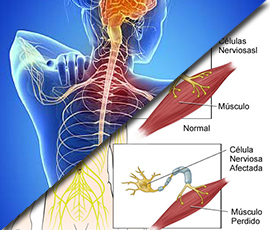 Amyotrophic lateral sclerosis (ALS)
Amyotrophic lateral sclerosis (ALS)
Amyotrophic lateral sclerosis (ALS), sometimes called Lou Gehrig's disease, is a rapidly progressive, invariably fatal neurological disease that attacks the nerve cells (neurons) responsible for controlling voluntary muscles (muscle action we are able to control, such as those in the arms, legs, and face).
The disease belongs to a group of disorders known as motor neuron diseases, which are characterized by the gradual degeneration and death of motor neurons.
Motor neurons are nerve cells located in the brain, brain stem, and spinal cord that serve as controlling units and vital communication links between the nervous system and the voluntary muscles of the body.
Messages from motor neurons in the brain (called upper motor neurons) are transmitted to motor neurons in the spinal cord (called lower motor neurons)and from them to particular muscles.
In ALS, both the upper motor neurons and the lower motor neurons degenerate or die, and stop sending messages to muscles. Unable to function, the muscles gradually weaken, waste away (atrophy), and have very fine twitches (called fasciculations). Eventually, the ability of the brain to start and control voluntary movement is lost.
ALS causes weakness with a wide range of disabilities. Eventually, all muscles under voluntary control are affected, and individuals lose their strength and the ability to move their arms, legs, and body. When muscles in the diaphragm and chest wall fail, people lose the ability to breathe without ventilatory support. Most people with ALS die from respiratory failure, usually within 3 to 5 years from the onset of symptoms. However, about 10 percent of those with ALS survive for 10 or more years.
At the onset of ALS the symptoms may be so slight that they are frequently overlooked. With regard to the appearance of symptoms and the progression of the illness, the course of the disease may include the following:
•Muscle weakness in one or more of the following: hands, arms, legs or the muscles of speech,
swallowing or breathing
•Twitching (fasciculation) and cramping of muscles, especially those in the hands and feet
Impairment of the use of the arms and legs
•"thick speech" and difficulty in projecting the voice
•In more advanced stages, shortness of breath, difficulty in breathing and swallowing
Stem cells have an unparalleled regenerative capacity and the flexibility to grow into hundreds of different types of cells, and also make factors that can protect cells.
The ideal approach would take advantage of these characteristics to replenish the stores of motor neurons as well as other needed cell populations to protect motor neurons and to restore the microenvironment in the brain and spinal cord.
•The ALS Association: http://www.alsa.org/about-als/symptoms.html

Av. Masferrer South. Urb. Maquilishuat No. 1006. San Salvador, El Salvador. CA.
(503) 2268-5999 Fax. 2268-5910
www.stemcell-elsalvador.com - info@stemcell-elsalvador.com